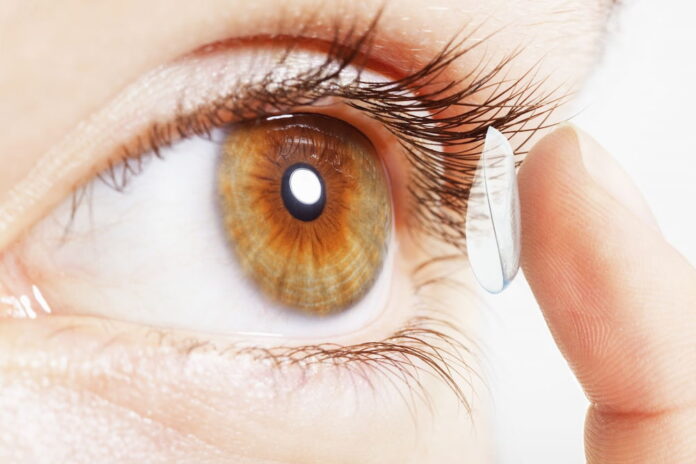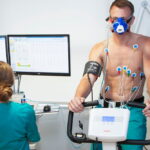Multifocal contact lenses are designed to provide people with presbyopia, a condition that typically develops in middle age, with clear vision at multiple distances without the need for reading glasses. These lenses combine different prescriptions into a single lens, allowing wearers to see near and far distances. Let’s talk more about how multifocal lenses work:
Presbyopia occurs when the lens in the eye stops changing shape, making it difficult to focus on objects up close. Traditionally, the solution to this problem has been to wear reading glasses or bifocal glasses, which contain two prescriptions in the same lens. However, many people find glasses uncomfortable or inconvenient, and they may prefer contact lenses as an alternative.
Multifocal contact lenses, like bifocal glasses, contain two or more prescriptions in the same lens. However, unlike bifocal glasses with a visible line separating the different prescriptions, multifocal contact lenses gradually transition from one prescription to another. It allows the wearer to see clearly at different distances without needing different lenses or glasses, you can check the latest multifocal contact lenses offers from contactlenses4us
Types of multifocal contact lenses:
There are two types of multifocal contact lenses: simultaneous vision lenses and segmented lenses.
Simultaneous vision lenses, also known as concentric or center-near lenses, provide both near and far vision in the same area of the lens. The lens is designed with alternating rings of distance and near prescription, allowing the wearer to focus on objects at different distances by simply shifting their gaze.
This design is similar to the way the natural lens in the eye works, with different areas of the lens responsible for focusing on different distances.
Segmented lenses, also known as translating or alternating lenses, have two distinct areas of the lens with different prescriptions. The top of the lens is designed for distance vision, while the bottom is designed for near vision.
When the wearer looks straight ahead, the lens sits on the lower lid, and the distance prescription is in use. When the wearer looks down to read, the lens moves up, and the near prescription comes into focus. This movement is called lens translation and occurs naturally as the eye blinks and moves. Are you still confused about how to put in contacts? Read it!
Several factors must be considered when fitting a patient for multifocal contact lenses. The patient’s age, prescription, and visual needs will all play a role in determining the appropriate lens design.
The curvature of the cornea, the pupil’s size, and the lens’s position on the eye will also be considered to ensure a proper fit.
In addition to providing clear vision at multiple distances, multifocal contact lenses offer several other benefits. For example, they can provide a wider field of vision compared to traditional reading glasses or bifocals, as wearers do not need to look through different lens parts for different distances.
Multifocal contact lenses can also provide a more natural appearance than glasses, particularly for people who do not want the visible line of bifocal glasses.
Conclusion
Multifocal contact lenses combine different prescriptions into a single lens, allowing wearers to see near and far distances without needing reading glasses or bifocals. If you find issues with seeing things normally, then contact your doctor and find out.
Read Also
- Modern Approaches to Adolescent Mental Health Treatment for Lasting RecoveryWith increasing numbers of teens experiencing emotional and behavioral health concerns, adolescent mental health treatment has become more essential than ever. Conditions such as anxiety, depression, trauma and mood instability are on the rise, and effective support must evolve with these growing needs. Today’s treatment models blend evidence-based therapy with flexible access and holistic care, giving… Read more: Modern Approaches to Adolescent Mental Health Treatment for Lasting Recovery
- How to Find a 5-Star Dentist Near YouChoosing a dentist is more than just finding someone who can clean your teeth. It’s about selecting a trusted partner in your long-term oral health. A 5-star dentist not only provides excellent clinical care but also delivers a positive patient experience, from the moment you walk in until the moment you leave. Whether you’re new… Read more: How to Find a 5-Star Dentist Near You
- Your Easy-Peasy Guide to Brewing Amazing MatchaHey there! So, you’ve heard all the buzz about matcha – that vibrant green powder that’s not just pretty but packed with good stuff? It can seem a little fancy and intimidating at first, but trust me, making a delicious cup at home is simpler than you think. Forget complicated ceremonies for now; let’s just… Read more: Your Easy-Peasy Guide to Brewing Amazing Matcha
- Embracing Holistic Wellness: Insights from a Lansing, MI Health CenterReframing Health: Moving Beyond Symptom Management Treating only symptoms often offers quick relief, yet long-term results stay out of reach. When care zeroes in on isolated complaints, the bigger picture, such as stress, behavior, or lifestyle, often gets missed. Research shows that whole-person care, which looks at physical, emotional, and environmental factors, yields better outcomes… Read more: Embracing Holistic Wellness: Insights from a Lansing, MI Health Center
- VO₂ Max Testing Explained: What It Is & Why It Matters for Your HealthVO₂ max sounds like a term reserved for elite athletes, but it’s among the most accurate measures of your lifetime and general condition. Moreover, it goes beyond performance. Monitoring your VO₂ max will help you to ascertain your body’s capacity to control stress, its oxygen consumption efficiency, and your internal ageing process. If you have… Read more: VO₂ Max Testing Explained: What It Is & Why It Matters for Your Health






